Dual-purpose chicken breeds do not get better than the Speckled Sussex.
Not only will it grace your backyard with alluring looks, but it is a practical breed for productivity, maintenance, and care. It is also beginner friendly and a joy to keep.
Read on to find out more about this famous breed.
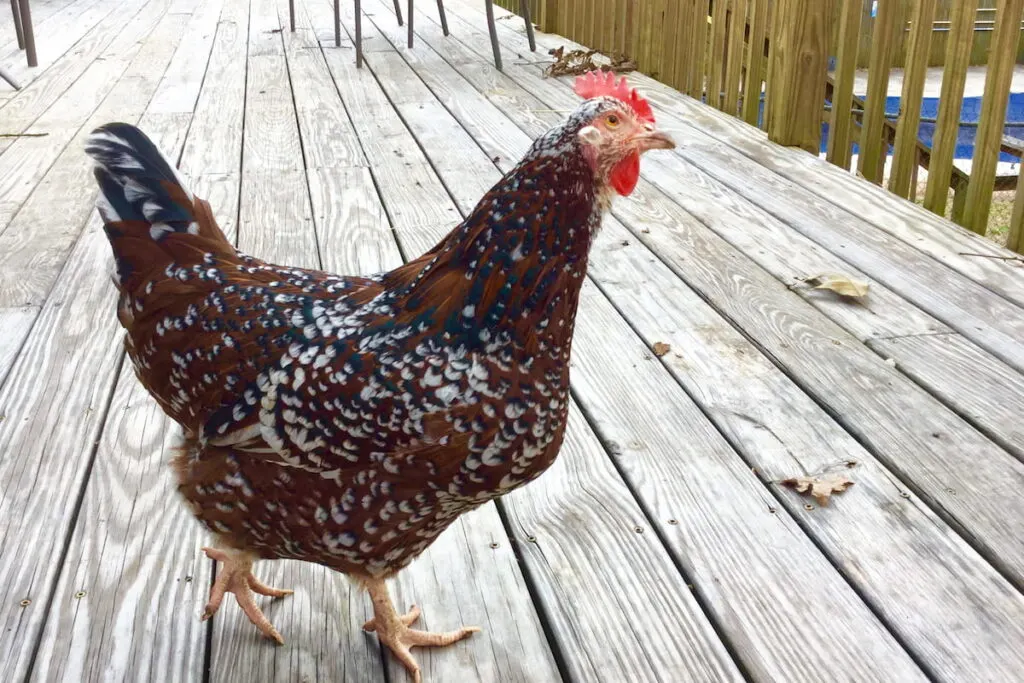
Table of Contents
History
Bred over a century ago, the Speckled Sussex chicken breed gets its name from its outstanding plumage and native county of Sussex, England.
Among the eight recognized varieties of the larger Sussex chicken breed, the Speckled Sussex is said to be the oldest.
American Poultry Association accepted the Speckled Sussex as an individual breed in 1922.
There is, however, no record of when it first appeared, but the breed’s first standard was developed in 1914.
It was initially referred to as Kent fowl or Old Sussex, and its ancestors were exhibited at the pioneering poultry standard show in 1845 at the London Zoo.
Until World War II when its fame receded, Speckled Sussex chickens were predominantly raised for meat production.
Appearance
The American Poultry Association classifies Speckled Sussex chickens as large fowls, for good reason. The birds have broad shoulders and a curvy, rectangular body.
Due to this shape, the bodies are somewhat deep and tall with their tails elevated at a 45-degree angle.
You will also notice that the birds have single five-pointed combs of a rich red color. Their ear lobes and wattles are also deep red.
The eyes have a reddish-orange shade while their pointy bills are horn colored. Unlike most chicken breeds, Speckled Sussex chickens have slightly pink skin and white shanks and toes.
Keep a keen eye on the shanks, as yellow ones can mean that a given bird is not a pure Speckled Sussex.
The chickens have dark mahogany plumage with white tips with black and luminous green bars. This coloration offers the perfect camouflage against predators.
The speckled patterns on these chickens increase every time they molt.
As such, you will have more beautiful spots to behold each year!
Chicks, on the other hand, usually have dark chestnut markings around their eyes, giving them a chipmunk-like look.
You will also notice that some chicks have dark brown stripes along their backs, while others have lighter stripes.
As the chicks get older, their adult markings begin to emerge; and with each molt, more speckles and white tips.
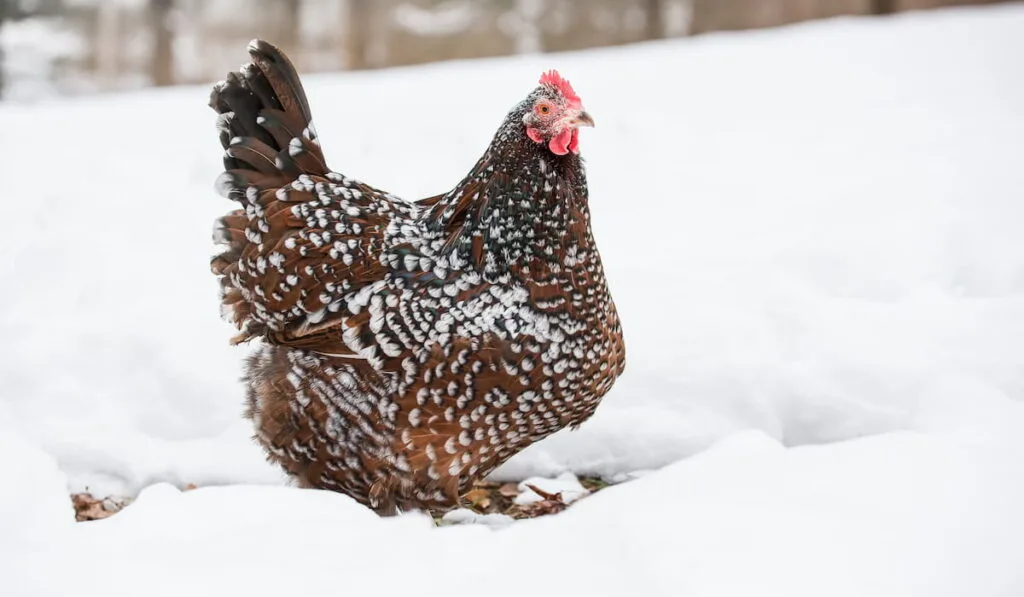
Size
Speckled Sussex roosters weigh around 9 pounds, while the hens weigh 7 pounds.
The Speckled Sussex chicken breed also has a bantam variety. Bantam hens weigh 30 ounces; roosters, 36 ounces.
Keep in mind that this bantam variety is quite difficult to find.
Uses
The Speckled Sussex chicken breed is a dual-purpose breed revered for its consistent egg and meat production.
Their large bodies and weight guarantee sizable meat production for commercial and subsistence purposes.
Egg Production
Being of the Sussex breed family, it is rather obvious that Speckled Sussex chickens are exceptional layers.
Depending on the strain you have, you can expect anything from 4 to 5 eggs per week.
Hens average 250 eggs annually.
Speckled Sussex hens mature at roughly 20 weeks of age, after which they will consistently lay light brown or tinted medium-sized eggs.
Keep in mind, however, that the number of eggs your hens lay is directly affected by how broody they are.
Other than broodiness, Speckled Sussex hens will only cease egg production when they molt. Other than these two incidents, they are consistent and dependable layers.
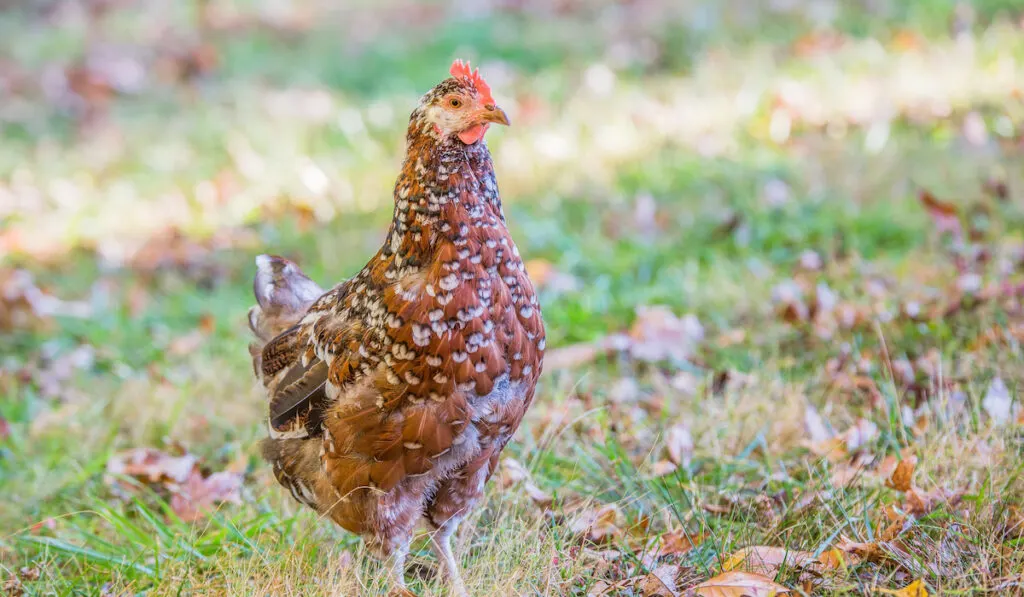
Meat Production
The Speckled Sussex’s large size makes it reliable for meat production — so much so that it was among the first commercial broiler breeds.
While it is not the breed of choice for industrial poultry farms today, it is undoubtedly a decent meat producer, especially when raised the right way.
At 7 to 9 pounds, these birds suit subsistence farming.
The chickens have juicy, pinkish-white meat. People say it’s exceptionally tasty.
Color
While Sussex chickens come in various color variations, the Speckled Sussex breed is only recognized in one color — a deep mahogany color with a rich green barring near the buff or white tips.
This coloration gives the plumage an eye-catching luminous hue when hit by sunlight.
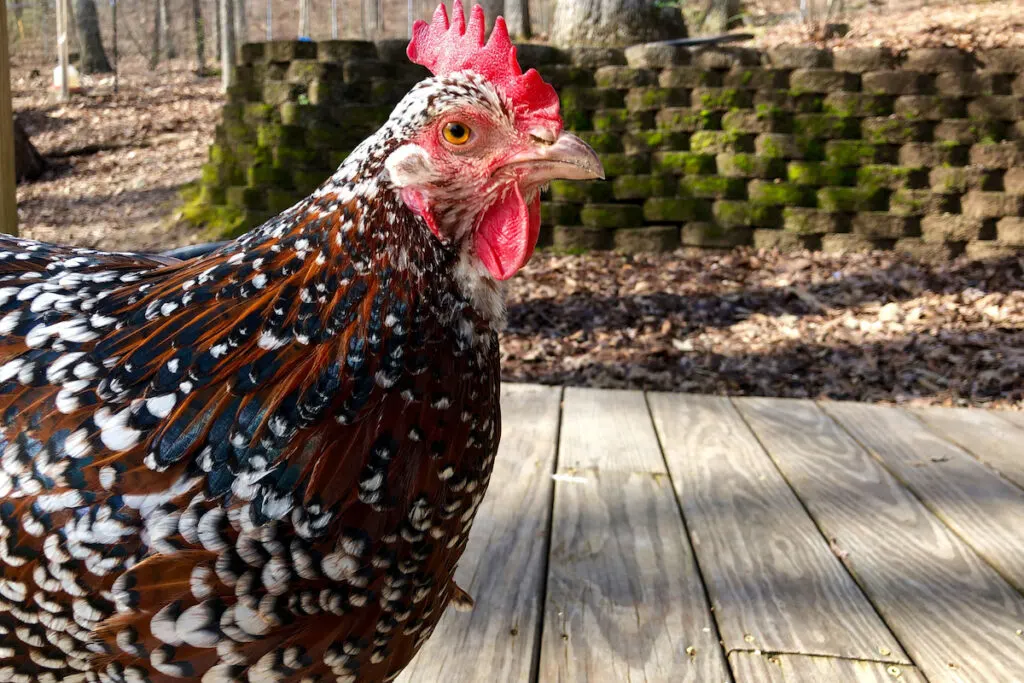
Temperament
Speckled Sussex chickens are generally friendly and gentle. As a result, the birds are perfectly suited as pets for adults and kids.
That being said, Speckled Sussex roosters are prone to having aggressive episodes and may not be safe for children.
The hens are especially steady and even-tempered and are not flighty or panicky.
You will notice that they love being chatty as you hold and pet them and will often follow you around if they think you are carrying treats to offer.
Lifespan
Speckled Sussex chickens usually reach maturity at roughly 20 weeks. Afterward, the hens are ready to start laying eggs while the roosters have a decent-sized carcass for table roasting.
If you are planning on using them for meat production, it’s best to raise your chickens for at least two more months so your birds can gain more weight.
Speckled Sussex chickens can live for up to 8 years if properly cared for.
Broodiness
In addition to their commendable egg production, Speckled Sussex hens also tend to go broody upon maturity.
When they do, they are great egg sitters and make caring mothers.
Noise Levels
The fact that the breed is rather quiet makes it suited for urban backyards.
You will seldom hear the chickens unless they have spotted a predator or when the hens are performing their egg song.
Even then, they are not prone to flightiness, as previously mentioned. And while they will often chat with you every chance they get, they are not loud.
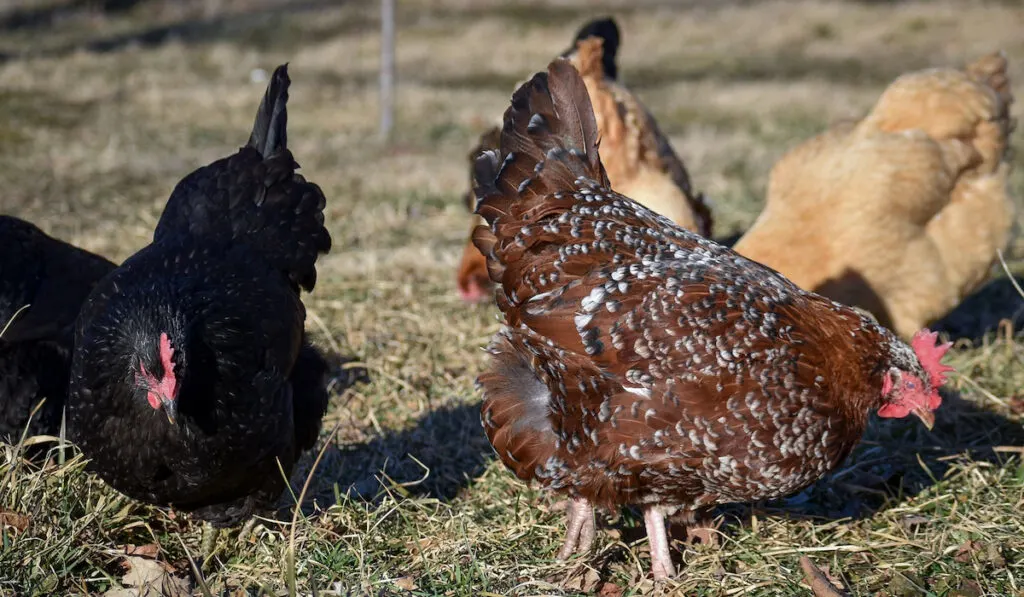
Diet and Nutrition
Speckled Sussex chickens are quite resourceful and cold-hardy.
As such, they excel at foraging for themselves when allowed to roam freely — they also tolerate confinement if you do not have room for free ranging.
Offer mature hens high-quality 16% layer feed and oyster shells for calcium to help with egg production and laying.
Consequently, increase their protein consumption to 20% when they start to molt to speed up their feathering process without diminishing their protein reserves.
Speckled Sussex chicks will also benefit from a high-protein diet to facilitate growth and feathering during their molt.
You can introduce broiler feed if you have roosters in your flock or other chickens you want to raise for meat production.
Be careful to not offer any layer feed to your roosters. An excess of calcium can easily kill them. To avoid this, always offer calcium to your laying hens separately.
Also, consider incorporating grit into your chickens’ feed if you raise them in a pen. This will go a long way in helping them with digestion.
Free-range chickens do not need grit except during winter when foraging grounds are frozen.
Housing
While Speckled Sussex chickens are in their element when roaming freely and foraging, having an enclosure where they can retire after a long day of exercise is paramount.
Being larger birds, 4 to 5 square feet of space per bird inside a coop will suffice. While they are lower in the pecking order, this space keeps mischief at bay, especially during prolonged confinement periods.
As far as roosting space goes, 8 to 10 square inches is enough for each chicken, except when they are sharing the space with other aggressive chicken breeds. In which case, separate roosting perches will come in handy.
Give your hens 12×12-inch nesting boxes.
Ideally, this will ensure that only one bird nests at a time in a given box. A ratio of one nesting box for every 3 hens will do.
If you do not have enough space to let them roam freely, having a run is the next best thing. Having 8 to 12 square feet per bird will allow the chickens to stay out of each other’s way when roaming.
Since they are not flighty, a fence of 4 to 5 feet is enough to keep Speckled Sussexes contained. Lastly, having tree stumps, ramps, and different height perches will keep your birds entertained.
Also, adjusting your coop and run accommodations to suit the various seasons will keep your Speckled Sussex chickens happy.
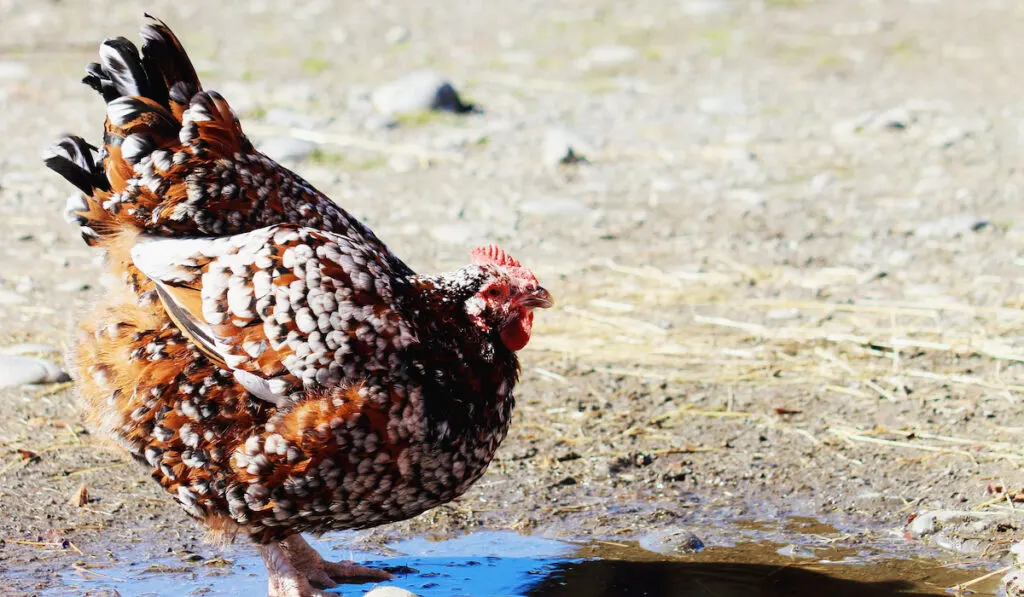
Common Health Issues
Speckled Sussex chickens are a rather healthy and robust breed — under the right conditions, these chickens can withstand almost any weather.
What’s more, the breed is not prone to any avian diseases.
However, it can suffer common chicken ailments:
- Lice
- Worms
- Mites
Seeking your vet’s advice on deworming will help keep your flock healthy.
Final Thoughts
Is the Speckled Sussex chicken breed right for you? This comes down to what you are looking for.
Luckily, this article highlights everything you need to know about this heritage breed from its egg and meat production to its temperament and care — all of which matter the most to any chicken keeper.
Resources:
- https://www.knowyourchickens.com/speckled-sussex-chicken/
- https://www.roysfarm.com/speckled-sussex-chicken/
- https://cs-tf.com/speckled-sussex/
- https://backyardpoultry.iamcountryside.com/chickens-101/sussex-chicken/
- https://www.thehappychickencoop.com/speckled-sussex/
- https://www.raising-happy-chickens.com/speckled-sussex.html#history
- https://www.chickensandmore.com/speckled-sussex/#Feeding
- https://www.heritageacresmarket.com/speckled-sussex/
- https://amerpoultryassn.com/accepted-breeds-varieties/
- https://en.wikipedia.org/wiki/Sussex_chicken
